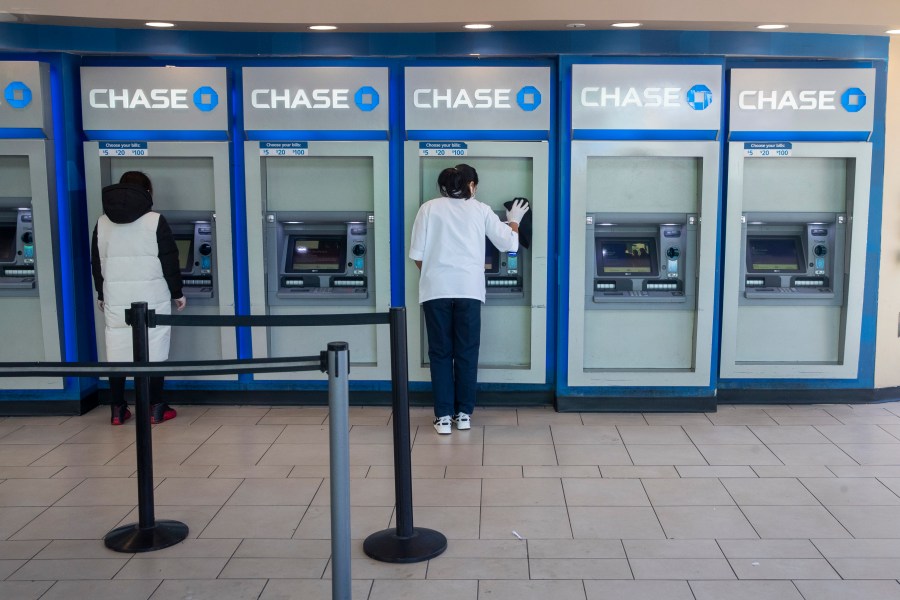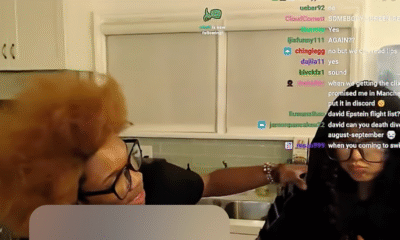Business
Consumer debt climbs as American credit card balances surpass $1 trillion on August 7, 2023 at 9:25 pm Business News | The Hill

Consumer debt grew $17.9 billion from May to June as a credit crunch brought on by Federal Reserve rate hikes drove a sharp gain in the amount of outstanding credit for payments like mortgages and car loans.
The numbers, which are not adjusted for inflation, come in well ahead of expectations at $13 billion and nearly double the increase from the previous month at $9.4 billion.
Debt levels on lump-sum purchases like houses and student loans increased $18.4 billion, offset by a 0.6 percent decrease in the amount of “revolving” credit, which includes things like credit cards and lines of credit.
The dip in revolving credit is catching the eye of economists.
“This is surprising and inconsistent with other data we have on consumer spending in the month,” economist Dean Baker with the Center for Economic and Policy Research told The Hill.
“These data are erratic and often subject to substantial revisions, but if we see another drop in July, that would indicate that some consumers are getting maxed out, and we may be in for a substantial slowing in consumption in the second half of the year,” Baker said.
Overall, Baker said, “the second quarter data shows modest credit growth. It fits with the story of consumption growing at a sustainable pace.”
A customer uses an ATM at a Bank of America location in San Francisco April 24, 2023. Bank of America is being ordered to pay more than $100 million to customers for double-dipping on some fees imposed on customers, withholding reward bonuses explicitly promised to credit card customers, and misappropriating sensitive personal information to open accounts without customer knowledge or authorization. (AP Photo/Jeff Chiu, File)
Credit card debt hits $1 trillion for US consumers
Despite the month-over-month decline in revolving credit, credit card debt weighing on U.S. consumers is at an all-time high of more than $1 trillion.
After rising steadily over the last decade, credit card debt levels started easing up in March, 2020, when the government started sending out checks to help households weather the coronavirus pandemic.
They fell by more than $100 billion over the following year, dropping to $736 billion in April, 2021. But then they started rising sharply once again during the booming recovery and are now above their pre-pandemic trend.
Secret spending: Americans are hiding their credit card debt
Total credit card debt is 11.6 percent higher than it was last year, down from a recent high of 18.4 percent last September.
As a share of disposable income, debt service payments are about where they were before the pandemic, hitting 5.7 percent in the first quarter of this year.
Credit card interest rates, along with mortgage rates and other types of financing that rely on charging interest, have been skyrocketing as the Federal Reserve has been raising the rate at which banks can lend each other money.
The average commercial bank interest rate on credit card plans is now above 20 percent, up from just 14.5 percent in February of last year, before the Fed started slowing the economy in response to higher inflation.
That’s the highest level on record for a payment method that is traditionally one of the most expensive ways for consumers to purchase goods and services.
While many measurements of the macroeconomy look healthy at the moment, with second-quarter gross domestic product doing better than expected and inflation dropping fast, it’s not clear that these conditions are extending beyond businesses and improving things for workers and consumers.
Most Americans are living paycheck to paycheck
A recent poll by Lending Club found that a majority of Americans say they are living “paycheck to paycheck.”
“In May 2023, 57 percent of consumers lived paycheck to paycheck,” the poll found.
More than 72 percent of people making less than $50,000 a year live “paycheck to paycheck” while 60.9 percent of people making between $50,000 and $100,000 annually live that way, according to the poll.
Census Bureau data shows that 85.4 million Americans used credit cards to pay their expenses in the last seven days.
The tab is ticking up: Americans owe $1 trillion in credit card debt
Solei Phim, a New York city resident, told The Hill her credit card use has been going up recently for regular expenses including food and laundry. She said she tries to pay her balance off every month so as not to incur interest payments.
“We keep it for the [end of the] month. We try to keep [expenses] within the month and try not to make it past that, but we are using it more frequently,” she said.
Phim added that she put the government stimulus checks she received from both the Trump and Biden administrations over the course of the pandemic into her family’s savings.
Many Americans did the same, leading to a surge in personal savings that gave workers some additional flexibility and likely contributed to high levels of churn in the job market.
Business, News, consumer credit, credit, credit cards, federal reserve Consumer debt grew $17.9 billion from May to June as a credit crunch brought on by Federal Reserve rate hikes drove a sharp gain in the amount of outstanding credit for payments like mortgages and car loans. The numbers, which are not adjusted for inflation, come in well ahead of expectations at $13 billion and…
Business
Why 9 Million Americans Have Left

The Growing American Exodus
Nearly 9 million Americans now live outside the United States—a number that rivals the population of several states and signals a profound shift in how people view the American dream. This mass migration isn’t confined to retirees or the wealthy. Thanks to remote work, digital nomad visas, and mounting pressures at home, young professionals, families, and business owners are increasingly joining the ranks of expats.

Rising Costs and Shrinking Wallets
Living in the US has become increasingly expensive. Weekly grocery bills topping $300 are not uncommon, and everyday items like coffee and beef have surged in price over the last year. Rent, utilities, and other essentials also continue to climb, leaving many Americans to cut meals or put off purchases just to make ends meet. In contrast, life in countries like Mexico or Costa Rica often costs just 50–60% of what it does in the US—without sacrificing comfort or quality.
Health Care Concerns Drive Migration
America’s health care system is a major trigger for relocation. Despite the fact that the US spends more per person on health care than any other country, millions struggle to access affordable treatment. Over half of Americans admit to delaying medical care due to cost, with households earning below $40,000 seeing this rate jump to 63%. Many expats point to countries such as Spain or Thailand, where health care is both affordable and accessible, as a major draw.

Seeking Safety Abroad
Public safety issues—especially violent crime and gun-related incidents—have made many Americans feel unsafe, even in their own communities. The 2024 Global Peace Index documents a decline in North America’s safety ratings, while families in major cities often prioritize teaching their children to avoid gun violence over simple street safety. In many overseas destinations, newly arrived American families report a significant improvement in their sense of security and peace of mind.
Tax Burdens and Bureaucracy
US tax laws extend abroad, requiring expats to file annual returns and comply with complicated rules through acts such as FATCA. For some, the burden of global tax compliance is so great that thousands relinquish their US citizenship each year simply to escape the paperwork and scrutiny.
The Digital Nomad Revolution
Remote work has unlocked new pathways for Americans. Over a quarter of all paid workdays in the US are now fully remote, and more than 40 countries offer digital nomad visas for foreign professionals. Many Americans are leveraging this opportunity to maintain their US incomes while cutting costs and upgrading their quality of life abroad.

Conclusion: Redefining the Dream
The mass departure of nearly 9 million Americans reveals deep cracks in what was once considered the land of opportunity. Escalating costs, inaccessible healthcare, safety concerns, and relentless bureaucracy have spurred a global search for better options. For millions, the modern American dream is no longer tied to a white-picket fence, but found in newfound freedom beyond America’s borders.
Business
Will Theaters Crush Streaming in Hollywood’s Next Act?

Hollywood is bracing for a pivotal comeback, and for movie lovers, it’s the kind of shake-up that could redefine the very culture of cinema. With the freshly merged Paramount-Skydance shaking up its strategy, CEO David Ellison’s announcement doesn’t just signal a change—it reignites the passion for moviegoing that built the magic of Hollywood in the first place.

Theatrical Experience Roars Back
Fans and insiders alike have felt the itch for more event movies. For years, streaming promised endless options, but fragmented attention left many longing for communal spectacle. Now, with Paramount-Skydance tripling its film output for the big screen, it’s clear: studio leaders believe there’s no substitute for the lights, the hush before the opening credits, and the collective thrill of reacting to Hollywood’s latest blockbusters. Ellison’s pivot away from streaming exclusives taps deep into what unites cinephiles—the lived experience of cinema as art and event, not just content.
Industry Pulse: From Crisis to Renaissance
On the financial front, the numbers are as electrifying as any plot twist. After years of doubt, the box office is roaring. AMC, the world’s largest theater chain, reports a staggering 26% spike in moviegoer attendance and 36% revenue growth in Q2 2025. That kind of momentum hasn’t been seen since the heyday of summer tentpoles—and it’s not just about more tickets sold. AMC’s strategy—premium screens, with IMAX and Dolby Cinema, curated concessions, and branded collectibles—has turned every new release into an event, driving per-customer profits up nearly 50% compared to pre-pandemic norms.
Blockbusters Lead the Culture
Forget the gloom of endless streaming drops; when films like Top Gun: Maverick, Mission: Impossible, Minecraft, and surprise hits like Weapons and Freakier Friday draw crowds, the industry—and movie fans—sit up and take notice. Movie-themed collectibles and concession innovations, from Barbie’s iconic pink car popcorn holders to anniversary tie-ins, have made each screening a moment worth remembering, blending nostalgia and discovery. The focus: high-impact, shared audience experiences that streaming can’t replicate.
Streaming’s Limits and Studio Strategy
Yes, streaming is still surging, but the tide may be turning. The biggest franchises, and the biggest cultural events, happen when audiences come together for a theatrical release. Paramount-Skydance’s shift signals to rivals that premium storytelling and box office spectacle are again at the center of Hollywood value creation. The result is not just higher profits for exhibitors like AMC, but a rebirth of movie-going as the ultimate destination for fans hungry for connection and cinematic adventure.

Future Forecast: Culture, Community, and Blockbuster Dreams
As PwC and others warn that box office totals may take years to fully catch up, movie lovers and industry leaders alike are betting that exclusive theatrical runs, enhanced viewing experiences, and fan-driven engagement are the ingredients for long-term recovery—and a new golden age. The Paramount-Skydance play is more than a business move; it’s a rallying cry for the art of the theatrical event. Expect more big bets, more surprises, and—finally—a long-overdue renaissance for the silver screen.
For those who believe in the power of cinema, it’s a thrilling second act—and the best seat in the house might be front and center once again.
Business
Why Are Influencers Getting $7K to Post About Israel?

Influencers are being paid as much as $7,000 per post by the Israeli government as part of an expansive and sophisticated digital propaganda campaign. This effort is designed to influence global public opinion—especially among younger social media users—about Israel’s actions in Gaza and to counter critical narratives about the ongoing humanitarian situation.

How Much Is Being Spent?
Recent reports confirm that Israel has dedicated more than $40 million this year to social media and digital influence campaigns, targeting popular platforms such as TikTok, YouTube, and Instagram. In addition to direct influencer payments, Israel is investing tens of millions more in paid ads, search engine placements, and contracts with major tech companies like Google and Meta to push pro-Israel content and challenge critical coverage of issues like the famine in Gaza.
What’s the Strategy?
- Influencer Contracts: Influencers are recruited—often with all-expenses-paid trips to Israel, highly managed experiences, and direct payments—to post content that improves Israel’s image.
- Ad Campaigns: State-backed ad buys show lively Gaza markets and restaurants to counter global reports of famine and humanitarian crisis.
- Narrative Management: These posts and ads often avoid overt propaganda. Instead, they use personal stories, emotional appeals, and “behind the scenes” glimpses intended to humanize Israel’s side of the conflict and create doubt about reports by the UN and humanitarian agencies.
- Amplification: Paid content is strategically promoted so it dominates news feeds and is picked up by news aggregators, Wikipedia editors, and even AI systems that rely on “trusted” digital sources.
Why Is This Happening Now?
The humanitarian situation in Gaza has generated increasing international criticism, especially after the UN classified parts of Gaza as experiencing famine. In this environment, digital public relations has become a primary front in Israel’s efforts to defend its policies and limit diplomatic fallout. By investing in social media influencers, Israel is adapting old-school propaganda strategies (“Hasbara”) to the era of algorithms and youth-driven content.
Why Does It Matter?
This campaign represents a major blurring of the lines between paid promotion, journalism, and activism. When governments pay high-profile influencers to shape social media narratives, it becomes harder for audiences—especially young people—to distinguish between authentic perspectives and sponsored messaging.

In short: Influencers are getting $7,000 per post because Israel is prioritizing social media as a battleground for public opinion, investing millions in shaping what global audiences see, hear, and believe about Gaza and the conflict.

 Business4 weeks ago
Business4 weeks agoDisney Loses $3.87 Billion as Subscription Cancellations Surge After Kimmel Suspension

 Entertainment4 weeks ago
Entertainment4 weeks agoWhat the Deletion Frenzy Reveals in the David and Celeste Tragedy

 Entertainment4 weeks ago
Entertainment4 weeks agoABC Suspends ‘Jimmy Kimmel Live!’ Indefinitely After Kirk Remarks

 Entertainment3 weeks ago
Entertainment3 weeks agoExecutive Producer Debut: How Celia Carver Created Festival Hit ‘Afterparty’

 Film Industry4 weeks ago
Film Industry4 weeks agoCan Movie Theaters Steal the Show from Streaming?

 Health4 weeks ago
Health4 weeks agoRussia Claims 100% Success With New mRNA Cancer Vaccine

 News4 weeks ago
News4 weeks agoBody of Missing Teen Found in Tesla Linked to Musician D4vd

 Business4 weeks ago
Business4 weeks agoWhy Small Theaters Are Thriving While the Industry Struggles




























